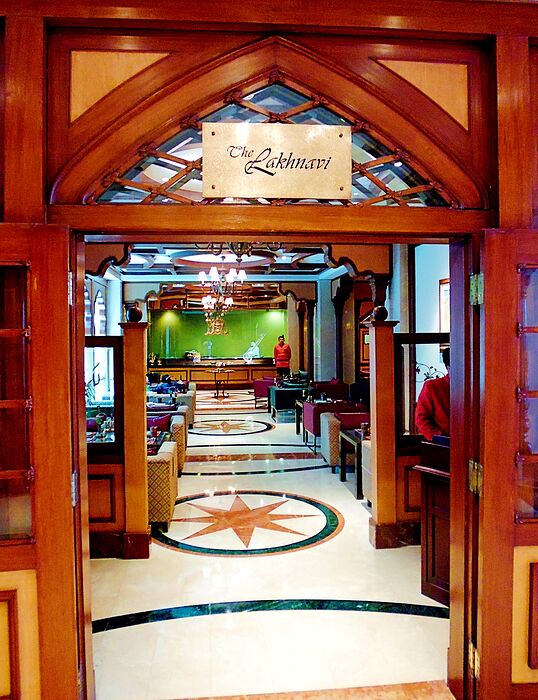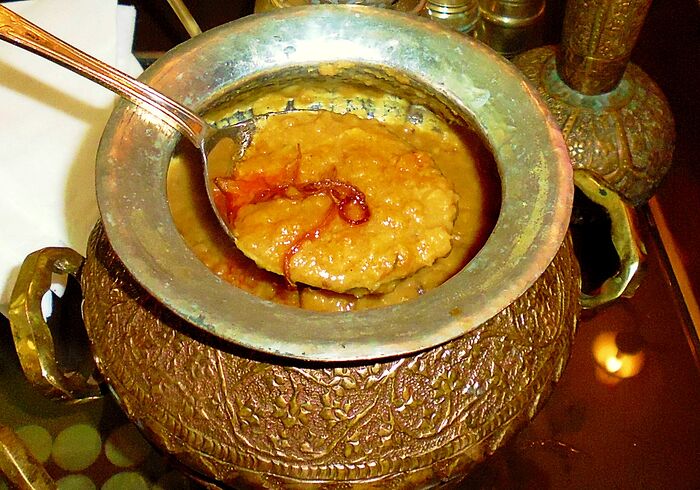Yet another old Chowhound post (this one from 24 Aug 2014) which I’m transferring over to Hungry Onion.
Today, The Lakhnavi is still at the forefront of fine dining in not just Lahore, but Pakistan as a whole.
=================================================
The Lakhnavi boasts of a 200-year-old culinary legacy that traces its lineage back to the royal chefs of the Nawabs of Awadh.
It all started back in the 18th-century when the reigning Nawab of Awadh issued a royal decree to the well-known Lucknow master chef, Qureshi, to create a suitable, healthy diet for the masses in his kingdom. Apparently, Qureshi went on to concoct a range of sublime dishes which so impressed the Nawab that he was invited to become the Nawab’s own Royal Chef, with a carte blanche to run the royal kitchens in the Nawab’s palaces in any way he saw fit.
Two centuries later, his direct descendants were still held in high regard by both India and Pakistan’s culinary fraternities.
The Qureshi brothers, Ashfaque and Irfan, after apprenticing under their father, the legendary Imtiaz Qureshi (often regarded as one of India’s best chefs) now helm The Lakhnavi at the elegant Avari Hotel in Lahore.
The ornately-decorated restaurant is located next to a beautiful center courtyard with a radical cutting-edge modernistic water-feature. It was by far the most elegant restaurant I’d come across in Lahore, and serving royal Awadhi cuisine, which is well-known for its “slow-cooking in sealed pots” (dum) technique, as well as use of saffron and cardamom to scent and flavor its richly-spiced mutton and paneer dishes. Awadhi cuisine is famous for its refined Persian-influenced kebabs, biriyani rice, and a rich selection of flatbreads like sheermal, taftan, roomali roti and warqi parathas.
The open-kitchen:
We started off with:
-
Makai ki Roti (cornmeal flatbread), served with various dips: tamarind, mint, and sweet green papaya chutney. Fried in ghee, the flatbread was denser and chewier than the more common chapati. The version here was also spiked with very spicy chopped green chilis, worked into the cornmeal dough.
-
Jaam-e-Jam - cold milk, flavoured with cardamom and cloves, and served in earthenware vessel which kept the milk cool. It was refreshing and a perfect start to the meal.
Appetisers
-
Murgh o Baadaam: intensely-flavoured chicken broth, flavoured with almonds & saffron, and containing some very delicate pea-sized chicken meatballs. It was one of the tastiest soups I’d had in Pakistan so far (and I’m into my 3rd week here).
-
Kaakori Kabaab: smoked beef with cardamom, clove and dried rose petals, with saffron; the beef mixture was finely hand-chopped till pate-like, before being charcoal-grilled.
The version here was decidedly more refined and subtly-flavoured, compared to the cardamom-heavy renditions I’d had in the Taj Hotel chain’s fine dining restaurants in India (Delhi, Mumbai, Bangalore, Chennai) in the past.
Mains:
-
Murgh e Bay Misal: this dish was described on the menu as “chicken in a lustrous tomato, onion and garlic curry with a dash of yoghurt, seasoned with cinnamon, clove and tandoori spices”. It sounded pretty interesting, but what I got turned out to be a rather standard bog tomato-and-spice curry which one can find from Bombay to Brick Lane ( for some reason, I’d expected the dish to be more fascinating).
-
Sultaani Daal: described as an Avadhi specialty of slow-cooked “arhar-dhal” (pigeon pea dhal) with fresh tomatoes and garlic, then finished off with white yoghurt. It turned out to be another average-tasting dhal lentil dish, albeit slightly over-salted. Nowhere near the ITC Group’s famous Dhal Bukhara in Mumbai, Delhi & Bangalore. I’m beginning to wonder if I’d pitched my expectations too high here.
-
Qandhari Naan: Whole-wheat bread with a sprinkling of chopped pistachios, almonds and raisins, baked in clay tandoor. Now, this was truly excellent - perfect textured, and very aromatic as it came piping hot from the tandoor oven.
Dessert:
- Shahi Tukra: best described as the Indo-Pakistan answer to bread-and-butter pudding. Here, it consisted of golden-fried bread that’s been soaked in milk & syrup, covered with a saffron-infused “rabhri” (caramelised, sweetened, condensed milk), then garnished with almonds, pistachio and “chandi ke varaq” (edible silver foil). The resultant pudding was light, and (thankfully) not overly-sweet like most desserts in Lahore tend to be. Totally delish.
Exceptionally professional and very efficient service here - the wait-staff were confident and conversed very well, and made some very good recommendations.
Lahore is a very interesting city, with busy streets filled with all manners of vehicles, and some very elegant colonial-era buildings left over from the British Raj period. Pakistani cities, on the whole, are better planned, and have better roads, than their Indian counterparts.
I filmed this enroute to The Lakhnavi:
Address
The Lakhnavi at the Avari Hotel Lahore
87 Shahrah-e Quaid-e-Azam, Lahore 54000, Pakistan
Tel: +92-4236366366



















